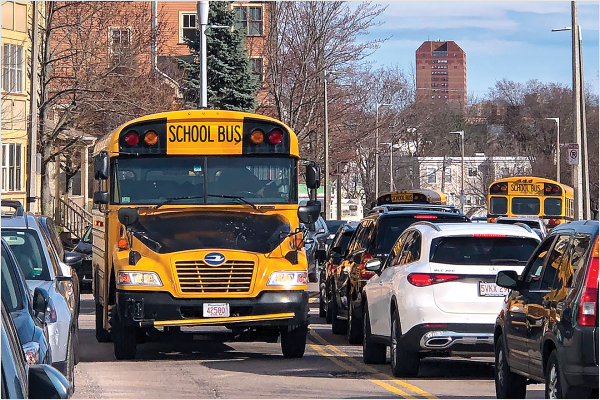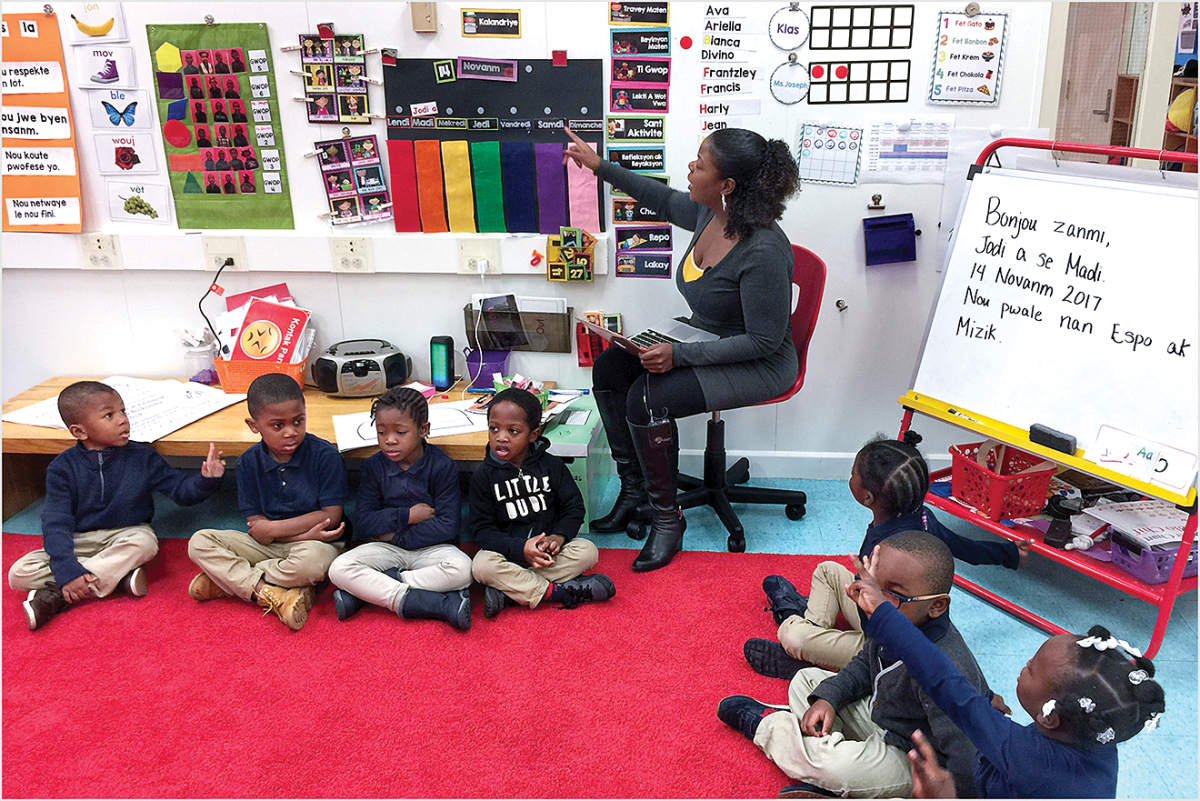April 2, 2025

School buses last week near James W. Hennigan K-8 School in Jamaica Plain. A report issued last week by the state’s Dept. of Elementary and Secondary Education found improvement in BPS bus performance after a shaky start last September. Chris Lovett photo
‘Concerted effort’ cited, but positive shift in ‘core factors’ isn’t happening, report notes
After five years of state intervention, with no clear gain in test results, the grade for the Boston Public Schools (BPS) was “mixed.” What started just before the Covid-19 shutdown as a push for better outcomes wound up as a pat on the back for effort.
That was the assessment on March 25 from Russell L. Johnston, the acting commissioner of the Mass. Department of Elementary and Secondary Education (DESE). In his outgoing report to the Board of Elementary and Secondary Education (BESE), he summarized both progress and unmet goals for the Boston schools in connection with the three-year “Systemic Improvement Plan” put in place by a second memorandum of understanding with DESE in 2022.
Johnston credited Boston officials, including Mayor Wu, with a “really concerted effort,” telling BESE members: “They met a lot of those initial benchmarks and have continued to grow the work beyond in the spirit of identifying those eight areas that are in the systemic improvement plan that relate to things like facilities, transportation, multilingual learners, inclusion – all very important areas that they have put just incredible work and thoughtfulness into. And I think there’s just agreement between the district and DESE that there’s still work to be done even after this three-year period.”
In its 2024 accountability report, DESE found “moderate progress” in the BPS, with some academic progress and even greater improvement in combatting chronic absenteeism. In a statement on March 25, Boston School Superintendent Mary Skipper emphasized a continued increase in the system’s five-year graduation rate and the percentage of school buses running on time. She also noted new educational partnerships and expanded programs for language learners.
“Over the three years,” said Skipper, “we have made notable progress in addressing systemic barriers and have enhanced our operational capacity, maintaining a laser focus on transportation. We are setting a high bar for transparency and on-time performance, which averaged 94 percent for the month of March, and through the Zūm technology platform, we continue to gather insightful data on yellow bus ridership and routing trends that will lead to future increases in on-time performance.”
Paul Reville, a former state education secretary and current professor at Harvard University’s Graduate School of Education, acknowledged that the agreement with Boston was less about academic outcomes than it was about process.
“States have modest capacity to help with improvement, so this kind of designation is really, I think, more effective at increasing a sense of urgency than it is on actually solving the problems,” he said. “But the good news is it appears that the Boston Public Schools have responded over the past couple of years and put in place some of the mechanisms to deliver on higher performance. And we still need to hold the system accountable for that performance over time here, because it’s not enough to put in place the infrastructure; you actually have to execute. And students have to learn at higher levels, but we have to be smart about how we measure that learning.”
Coinciding with Wu’s first full year in office, the 2022 agreement was a sequel to the memo of understanding drawn up two years earlier with DESE under former mayor Marty Walsh and former BPS superintendent Brenda Cassellius. At the time, the measures of success, apart from graduation rates, were mainly based on scores from the state’s standardized MCAS test.
A comparison of BPS scores between 2019 and 2024—before and after disruptions from the Covid-19 pandemic—show a general lack of improvement. And, at the March 25 meeting, BESE vice chair Matt Hills shifted the focus to DESE’s previous yardstick—and what he called an “abysmal start” to student transportation last September.
“I know everybody’s trying,” he insisted. “I know nobody wants this, but I just kind of feel the need to highlight the academic and then this one operational issue.”
Even before the meeting, the lack of improvement in MCAS scores was highlighted in a report by the Boston Policy Institute (BPI). The report also noted that chronic absenteeism, following a post-pandemic peak, was at 34.6 percent for the year 2023-24. The figure in 2019 was 25.2 percent, described as “staggering” in a 2020 letter from former DESE Commissioner Jeffrey C. Riley that accompanied a scathing review of the BPS.
“We’ve had these agreements, they’ve led to some changes,” the BPI report’s author, Dr. Kerry L. Donahue, observed, “but we’re not getting at the systemic core factors, which was the reason for the whole intervention. The state shouldn’t be using its power to intervene to just require people to write plans. It should be to shift student and school outcomes in the performance of the district. And that has not transpired at this point.”

A Haitian-Kreyol/English dual language class at the Mattahunt Elementary School in Mattapan in 2017. Cited in the Mattahunt’s “School on the Move” award last year, the program is one example of the expanding options for BPS language learners. Chris Lovett photo
Even Riley’s letter in 2020 pointed to a lack of progress in the system’s lowest-performing schools, addressing “systemic barriers to equity,” and supporting the “most vulnerable” students. “While the Boston Public Schools has historically been among the country’s leading urban school districts,” DESE officials wrote in the report, “in student performance, improvement in student academic outcomes has been largely stalled for the past decade.”
During the decade, Boston had a change of mayoral administrations and a rapid turnover in superintendents. According to researchers for The Boston Foundation, between 2014 and 2022, the BPS and public charter schools also saw their share of “high-needs” students increase from 70.2 percent to 81.4 percent. In December 2024, after decades of declining enrollment, BPS reported an influx of 2,379 students over three years who were, according to a top official, “almost exclusively” immigrants.
Also affecting performance metrics, starting in 2017, was the adoption of the “Next-Generation” MCAS exams, with higher standards to promote college readiness. In the years that followed, the results showed continuing gaps between numbers for Black and Latino students, as opposed to white and Asian students. Students within the groups also had different levels of English proficiency and the number of years in the BPS.
Accounting for 45 percent of the BPS enrollment, Latinos are the system’s largest student population, including language learners and US-born students whose primary language is English. According to Lorna Rivera, the director of UMass Boston’s Mauricio Gastón Institute for Latino Community Development & Public Policy, the Latino category also includes recent older, unaccompanied minors from other countries, some with limited or interrupted formal education.
“We know what languages,” said Rivera, “but we don’t know the deeper piece there of that disaggregation.”
A comparison of BPS MCAS results between 2019 and 2024 for “Hispanic/Latino” students shows that, for grades 3-8 and 10, there was a decrease in the percentage meeting or exceeding expectations in all subjects, with the same tallies down for BPS students in total. But Reville cautioned that, because of shifting demographics and differing baselines, group results on MCAS have limited use as a measure of student progress.
“I assume that was a consideration in the state’s not over-focusing on those results,” he surmised, “because it absolutely has an effect. The population is changing, and the proportionate demographics are increasing for students with significant disadvantage, whether it’s poverty, language, or disability. And, therefore, you’re not comparing apples to apples. You’re not comparing the same population and you’ve got the chronic attendance problems post-Covid.”
In a letter to Skipper on March 24, Johnston pointed to improvements in special education services and language learners. In the fall of 2025, the BPS plans nine new “bilingual” education plans, including dual language programs coupling English with Spanish, Cape Verdean Kriolu, and Mandarin Chinese.
After the programs were announced last year, some advocates and parents criticized additional plans for English immersion and “inclusive” placement of language learners—some speaking different home languages — in classes taught in English. They argued that students would do better in classes with more use of their home language—by classmates and teachers. And Donahue, when asked about her report for BPI, said the BPS still lacks “a very clear or evidence-based plan” for language learners.
A pioneering dual language program in English and Haitian Creole at the Mattahunt Elementary School in Mattapan was a factor in last year’s top award for learning progress by the nonprofit school improvement fundraiser EdVestors. But Rivera acknowledged that a more transitional approach to language learning could also be more labor-intensive, with more need for training and professional development. Almost one-third of the BPS students are classified as “English Language Learners,” and they speak dozens of different languages—which Reville said could make matching with teachers more difficult.
Donahue also suggested other ways to boost achievement for the general student population. “I would look at high dosage tutoring as an option,” she said. “I would look at really strong evidence-based early literacy program, making sure every teacher is trained, that every school has a model for intervening when students aren’t making grade level progress.”
DESE commended the BPS for progress on facilities planning and information about enrollment projections. In January 2024, officials announced that as many as half the BPS schools could be closed in the coming years. In January of this year, Skipper and Wu announced plans to close three more schools at the end of 2025-26, with other schools being merged, reconfigured, or redesigned. The changes have met with opposition from parents, including those with children at the Dever Elementary School in Dorchester. But Donahue emphasized that reducing under-used capacity could allow more resources to be used for other needs.
“Now, you’ve got probably what’s an excess of classroom teachers for the number of kids you have,” she said. “You could move some of those people into becoming reading specialists or interventionists. Somebody needs to be thinking about a human capital strategy that aligns with the facilities plan, because that is where the majority of the money is.”
BPI’s executive director, Gregory Maynard, noted that DESE had drawn attention to problems with school facilities two years before the 2022 memo of understanding.
“I would say, if you were looking at how the agreement was intended to work when it was signed in June 2022,” Maynard argued, “that this was intended to be an opportunity for Boston to go and do the hard things that it had resisted doing so far. And that particularly is around right-sizing the number of Boston’s public schools.”
Boston officials also have to contend with changes in federal policy and funding. The US Dept. of Education supports programs for students with disabilities and literacy efforts for children in poverty, along with teacher training. The department has also measured progress and monitored programs for students with disabilities and language learners. President Trump is trying to eliminate the department, with some programs to be dismantled, and others shifted to a different federal agency or handed off with funding to state governments. The changes are currently facing legal challenges from several states.
According to Will Austin, the founder of the Boston Schools Fund, Trump’s action also comes after 2015 federal legislation scaling back federal and state initiatives that had been adopted under the 2002 “No Child Left Behind” Act.
“These reductions mean fewer people helping families afford college, protecting civil rights, and researching how to teach children better,” Austin wrote in his March 14 “Boston Focus” newsletter. “Regardless of one’s political or policy orientation toward local control, none of these three functions can or should be carried out by localities (which is why they are federalized to begin with).
“So, it is fair to assume these services will be diminished or completely go away. That appears to be the point.”
Boston officials are also concerned about the Trump administration’s immigration enforcement policies, including recent decisions to end “temporary protected status” (TPF) this year for Venezuelan and Haitian immigrants. The move is also facing legal challenges, along with prompting a resolution in opposition filed by three Boston city councilors.
Rivera says the change in enforcement is also causing anxiety at UMass Boston. “My students are really scared,” she said. “They’re not going to school — like these things in that [DESE] report. We’re worried about chronic absenteeism since Covid—kids haven’t been going. What are we doing?”
Reville said federal cuts in spending, including money for school meals, would affect anything from student outcomes to local budget decisions.
“These are factors that will affect attendance,” he said. “They will affect kids’ focus and motivation, and will affect the district’s ability to deliver at high quality levels. And I think that the general atmosphere, where the feeling is the sector is kind of under siege at the moment, is bound to affect performance at all levels.
“So, I’m very concerned in terms of where we’re headed on all this, but there’s so much uncertainty now that it makes building a budget complicated. Because, to some extent, [while] you have modest reliance on federal aid right now, it’s not clear whether that aid is going to be coming in that has been authorized by Congress.”


